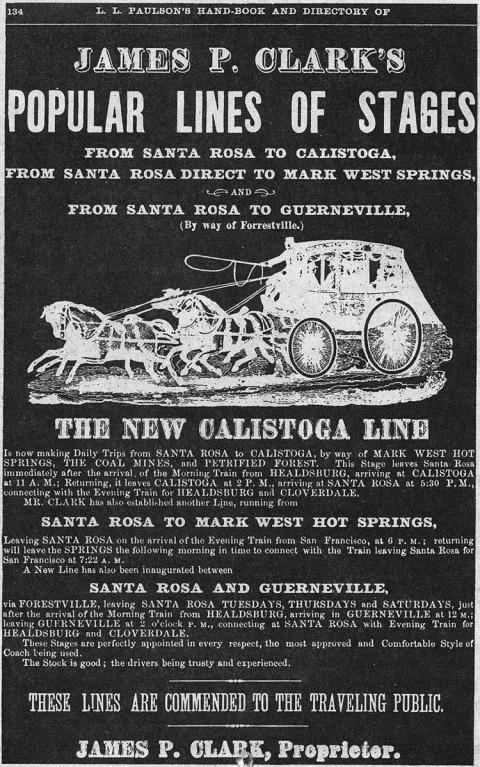To the Geysers with Clark Foss, World Renowned Stagecoach Driver
The Geysers, first discovered by the white man in 1847, became a very popular North Bay tourist attraction, particularly for the wealthy, beginning in the 1860's until the Geysers were capped for the production of power.
"The torn irregular walls around us glare with patches of orange, crimson, sulfur, livid gray, and fiery brown, which the last rays of the sun, striking their tops, turn into masses of smouldering fire. Over the rocks, crusted as with a mixture of blood and brimstone, pour angry cataracts of seething milky water. In every corner and crevice, a little piston is working or a heart is beating, while from a hundred vent-holes about fifty feet above our heads the steam rushes in terrible jets. I have never beheld any scene so entirely infernal in its appearance. The rocks burn under you; you are enveloped in fierce heat, strangled by puffs of diabolical vapor, and stunned by the awful, hissing, spitting, sputtering, roaring, threatening sounds-as if a dozen steamboats blowing through their escape-pipes, had aroused the ire of ten-thousand hell-cats..." (as reported by Bayard Taylor, journalist).
In the beginning, after the boat voyage from San Francisco and then train, a trip to the Geysers was completed on a stagecoach by way of Healdsburg and, then later, by way of Calistoga or Cloverdale. The views from Hog's Back Ridge at an elevation of about 3,000 feet and from Geyser Peak at 3,800 feet were stupendous. With Mt. Helena towering above and silent forests below rising up from foggy mists into motionless crystal clear air as far as the eye could see, "the scene was not merely beautiful, it was truly sublime," wrote William H. Brewer.
The trip by stage could be made only in dry weather, when the blinding, choking dust encouraged drivers to travel as fast as their horses could go. The trail was steep, sometimes dropping a thousand feet over a distance of only one mile, with sheer drop-offs from the road edge of several thousand feet. The road was narrow, often not even seven feet wide. Thus developed the most heart-pounding, adrenaline-pumping experience that brought people from near and far...the stagecoach ride to the Geysers with Clark Foss at the reins! It was no cheap thrill either, as the round trip fare of $50 was today's rough equivalent of $2,000.
Foss, a native of New Hampshire, stood well over six feet and weighed as much as 300 pounds. He established his own stage line in the 1860's and built a tavern at Sonoma County's Knight's Valley called Foss' Station or Fossville. There were 25 guest rooms with red plush draperies and crystal chandeliers in the big main room. On the return trip from the Geysers, Mrs. Foss treated the guests to a fabulous dinner. In the dry season, Foss made the round trip daily.
After a visit from Tom Thumb, Foss enhanced his "performance" with yells and by rounding curves on two wheels. His horses carried no bells as they were not necessary...Foss could be heard a half mile ahead. Clark Foss handled "four or six horses like you would handle that many cats. He would lift them right up off their feet and swing them around the corners so fast you couldn't see the leading team." Soon it was Clark Foss who was the main attraction and the Geysers were anticlimactic. His passengers included the wealthy and famous from around the world. At first they called him Captain Foss, then Colonel, and General. Finally, he was known as the Old Chieftain.
It was quite a show. His yellow dog barked and ran between the rear wheels, with Foss "Alternately coaxing and encouraging his horses up the steepest acclivities, his eye sparkles at the top as he gathers the reins, carefully places his foot on the brake, turns half around and looks over the coach to see that the passengers are all there, when 'crack' goes the whip, a shout to the horses, and away we go down the steep mountainside. Trees fly past like the wind; bushes dash angrily against the wheels; the ladies shut their eyes and grasp the arm of some male passenger; and speed down the declivity with lightening rapidity, the horses on a live jump, and General Foss, whip in hand, cracking it above their heads to urge them on." The descent into Pluton Canyon was said to be "like riding down the roof of a Gothic church" (as reported by an unnamed tourist).
Robert Louis Stevenson immortalized Clark Foss in The Silverado Squatters: "Flinching travelers, who behold themselves coasting eternity at every corner, look with natural admiration at their driver's huge, impassive, fleshy countenance..." Some pronounced Foss the best stagecoach driver in the world.
It was inevitable that someday Clark's skill would not be enough. His speeding stage plunged down into a canyon, killing one young lady. Six other people, including Foss, were badly injured. After that, Foss drove with more reserve. He retired in 1881, handing over the reins to his son Charley, who had been driving at Yosemite. As blustery and spectacular as Clark was, Charley was gentle, polite, and safe. Charley's lead horses wore bells and he drove down Hog's Back at ten miles per hour.
Clark Foss died at his Calistoga home
Resources:
- Dutton, Joan Parry. They Left Their Mark, famous passages through the wine country. St. Helena: Illuminations Press, 1983 [Call number at SSU: Circulating Stacks and the Regional Room F868 .S132 D87 1983]
- Munro-Fraser, J. P. History of Sonoma County. San Francisco: Alley, Bowen & Co., 1880.
- Stanton, Ken. Mount St. Helena & R.L. Stevenson State Park, a history and guide. Calistoga: Illuminations Press, 1993
- [Call number at SSU: Regional Room F868 .S132 S73 1993]


